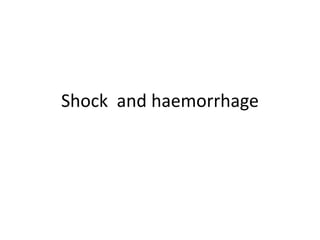This document discusses shock and hemorrhage. It defines shock and classifies it into hypovolaemic, cardiogenic, obstructive, distributive, and endocrine shock. Cardiogenic shock is caused by cardiac pump failure, while hypovolaemic shock is caused by decreased intravascular volume from hemorrhage or fluid loss. Distributive shock results from diminished systemic vascular resistance and includes septic, anaphylactic, and neurogenic shock. The document further discusses the pathogenesis and treatment of septic shock, hemorrhage classification, and methods of determining acute blood loss.





































